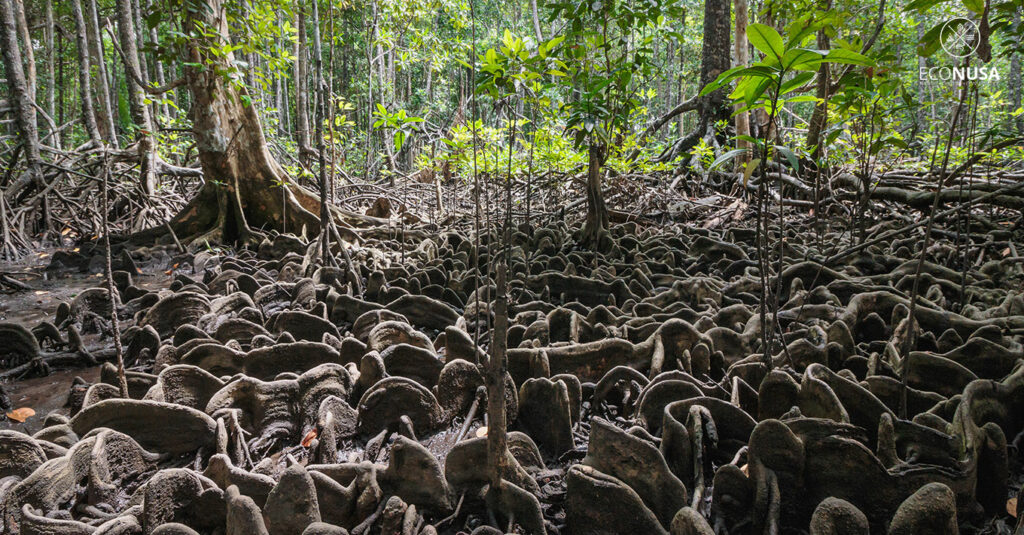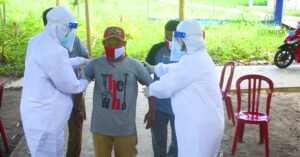
Rehabilitation of mangrove forests in Indonesia has got new hope at least until 2024. During mangrove planting at Raja Kecik Tourism Beach, Muntai Barat Village, Bantan Sub-district, Bengkalis Regency, Riau Province, on Tuesday 28 September 2021, President Joko Widodo said the government would rehabilitate 34,000 hectares mangrove by end of 2021 and would run for the other 600,000 hectares by 2024.
“We hope we will improve this area. We rehabilitate it to control abrasion in support of ecotourism, local tourism and of course we also hope it will support community economy surrounding the area,” said Jokowi.
Degraded Mangrove
Mangrove forest is not in good condition. In the last three decades, mangrove degradation in Indonesia is the fastest in the world. According to Minister of Environment and Forestry Siti Nurbaya Bakar, the degraded mangrove has reached 600,000 hectares. In comparison, the size equals to more than nine times of Jakarta Province.
Read Also: Mangrove, Priceless Ecological Richness or Destruction
Mangrove spreads all over tropical and subtropical areas. The accumulation of the total mangrove areas of the two regions here is around 18 million hectares. As from the figure, Indonesia is on the first place with the largest mangrove area, or about 3.311 million hectares or 25 percent of the total of global mangrove, and Brazil is on the second with 8 percent and Australia 7 percent.
In Indonesia, mangrove does not spread evenly along the 95,000 kilometers of coastline. The center of mangrove ecosystem in Indonesia is on the land of Papua, with 1,634,041 hectares in Papua as the largest and 473,059 hectares in West Papua.
Citing netizen words, it is not too much to say that “mangrove is koentji (key)”. The existence of mangrove ecosystem provides priceless value to the surrounding creatures, not only human but also coral reef and fishery resources.
Mangrove is the key to save fishery resource, coral reef biodiversity, fishery resources, and community food security. The community living surrounding the forest and mangrove could harvest shrimp, eel, fish, crab, and sea snail.
Mangrove is Key
Mangrove ecosystem serves as a buffer for abrasion, reduces storm, tsunami and sea water. Lecturer of Marine Science of Diponegoro University, Rudhi Pribadi, said that some mangrove species such as Avicennia species with quite large size could serve as the “natural wall”. Rudhi who once studied mangrove in Papua found large sized mangrove with four stretching adult arms in diameter. “The condition of (mangrove) vegetation depends on the location it grows, species, and disruption,” he said.
Read Also: The More Mangi-Mangi, The More Crabs
Ecologically speaking, mangrove ecosystem becomes the breeding spot for fish resources. The ecological function has benefited villagers at Mandoni Village, Kokas District, Fakfak Regency. Upon visiting Mandoni, which is dubbed “Mangrove Crab Village”, Mangrove Expedition team met Mariam Kramandondo, a local woman, who searched for crabs. On the rainy season, she could catch 50 large sized crabs.
Mangrove ecosystem also has very significant function as mangrove vegetation could catch carbon. A study published on the Nature journal found that mangrove could save carbon three to five times higher than that of tropical rainforests. In other words, there are 3.14 billion tons of carbon saved by mangrove ecosystem in Indonesia.
The good will to rehabilitate mangrove forests deserves an appreciation. EcoNusa’s Coordinator for Ocean Advocacy and Policy, Gadri Ramadhan Attamimi, thought that mangrove rehabilitation showed government effort to meet the contribution target as set by the Nationally Determined Contribution (NDC) to reduce greenhouse gas emission by 29 percent with its own struggle and 41 percent with international supports by 2030. The acceleration here goes along with Indonesia’s commitment in the Paris Agreement to work in cooperation with other countries in preventing global temperature from rising to 2 Celsius degree and hold it up to 1.5 Celsius degree.
Read Also: Mai Mai Peoples Building Food Security from Home
Mangrove rehabilitation copes with specific challenge. The Peat and Mangrove Restoration Agency (BRGM) identified some challenges in mangrove rehabilitation such as the difficulties in finding seeds, weather on the rehabilitation spot, and even social rebuff among the community that has made mangrove areas into pond and cultivation areas.
To restore mangrove up to 2024, BRGM estimated that it would cost Rp 18 trillion to restore around 673,000 hectares of mangrove. Without participation of all community elements, NDC will be away from its target and the community life surrounding mangrove forests would never get better.
“To ensure the target of mangrove restoration, all social elements should work together. Public engagement should be participatory so that the grass root communities could get the benefits,” Gadri said.
Editor: Leo Wahyudi & Nur Alfiyah







